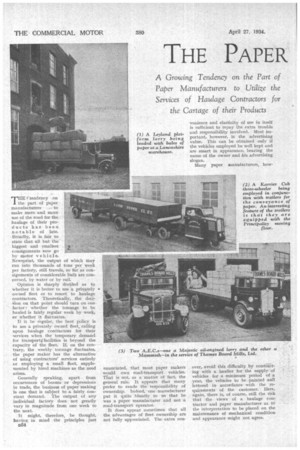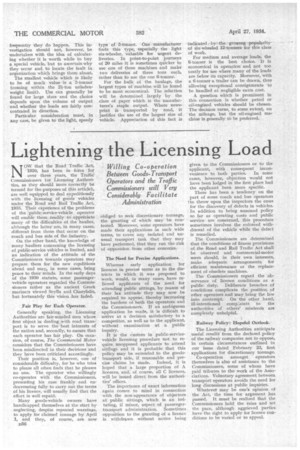THE PAPER
Page 120

Page 121

Page 122

If you've noticed an error in this article please click here to report it so we can fix it.
MAKER'S Reliance on
ROAD TRANSPORT
T' tendency on the part of paper
manufacturers to make more and more use of the road for the haulage of their products has been notable of late. Broadly, it is fair to state that all but the biggest and smallest consignments now go by motor vehicle. Newsprint, the output of which may run into thousands of tons per week per factory, still travels, so far as consignments of considerable bulk are concerned, by water or by rail.
Opinion is sharply divided as to whether it is better to use a privately owned fleet or to resort to haulage contractors. Theoretically, the decision on that point should turn on one factor : whether the tonnage to be hauled is fairly regular week by week, or whether it fluctuates.
If it he iegular, the best policy is to use a privately owned fleet, calling upon haulage contractors for their services when the temporary demand for transporttfacilities is beyond the capacity of the fleet. If, on the contrary, the weekly tonnage fluctuates, the paper maker has the alternative of using contractors' services entirely or employing a small fleet, supplemented by hired machines as the need arises.
Generally speaking, apart from occurrences of booms or depressions in trade, the business of paper making is one that is subject to a fairly constant demand, The output of any individual factory does not greatly vary in magnitude from one week to the next.
It might, therefore, be thought, having in mind the principles just
enunciated, that most paper makers would own road-transport vehicles. That is not, as a matter of fact, the general rule. It appears that many prefer to evade the 'responsibility of ownership. Indeed, one .manufacturer put it quite bluntly to us that he was a paper manufacturer and not a road-transport operator.
It does appear sometimes that all the advantages of fleet ownership are not fully appreciated. The extra con
ever, avoid this difficulty by contrating with a haulier for the supply of vehicles for a minimum period of a year, the vehicles to be :painted anll lettered in accordance with the requirements of the customer. Here, again, there is, of course, still the risk that the views of a haulage contractor and paper manufacturer as to the interpretation to be placed on the maintenance of mechanical condition and appearance might not agree. Some paper makers have circumvented this problem by the inclusion of a clause, rigidly interpreted, to the effect that the paintwork and general exterior condition of the vehicle shall be maintained in a manner which shall meet with their approval.
Sometimts this safeguard is carried farther by stipulating that oply vehicles of a certain age shall be used. This method of dealing with the transport problem is preferred by many. It enables the manufacturer to realize all the potentialities of ownership, whilst evading its responsibilities.
The best and most practical method of dealing with the transport problem is to effect a compromise between the extremes of complete ownership and entire reliance on haulage contractors. This can be done it a nucleus fleet be provided, either privately owned or operated under a contract such as that just outlined.
This fleet should be set to care for the transport of that part of the cornpany's output which is consistent, both as to quantity and direction. Hired vehicles can then be employed for the remainder. One concern of paper makers has adopted this plan with outstanding success.
The company we have in mind, is situated about 20 miles from London. Six-wheeled 10-12t o n vehicles are used for transport to London, there being regular daily deliveries in that direction. These lorriesare the property of the company, whereas all other transports is entrusted to haulage contractors.
The next con cideration is the size of vehicles that may be eltpected to be most economical in use and, concurrently, the design of bodywork. Con sidering paper. making in all its aspects, it might truly be said that, using some machines for one purpose and some for another, the choice might lie anywhere along the whole gamut of sizes available.
Opportunities for the economical employment of the smallest types are, however, rare. Paper is a heavy commodity and, even when the small. consigarnents to which reference has been made are being delivered, it seldom happens that there is not efiough of them to make up a load of upwards of two tons. Now and again odd parcels urgently wanted have to he delivered singly, bat-it is seldom that these occurrences are Irequent enough to justify the purchase of a vehicle specially for the purpose.
If there does seem to be a large number of such occasions, it is worth while to search back through the books for a year or so, to find out how frequently they do happen. This investigation should not, however, be undertaken with the idea of calculating whether it is worth while to buy a special vehicle, but to ascertain why they occur and, to locate the fault in organization which brings them about.
The smallest vehicle which is likely to be of much value is a 3-tonner (coming within the 2i-ton unladenweight limit). Use can generally be found for large sizes and the choice depends upon the volume of output and whether the loads are fairly con ccntrated in direction.
Particular consideration must, in any case, be given to the light, speedy type of 3-tonner. One manufacturer finds this type, especially the light six-wheeler, valuable For urgent deliveries. In point-to-point journeys of 20 miles it is sometimes quicker to use one of these machines and make two deliveries of three tons each, rather than to use the one 6-tonner.
For the bulk of the haulage, the largest types of machine will be found to be most economical. The selection will be determined largely by the class of paper which is the manufacturer's staple output. Where newsprint is transported by road, it justifies the use of the largest size of vehicle. Appreciation of this fact is indicated by the growing popularitynf six-wheeled 12-tonners for this class of work.
For medium and average loads, the 6-tonner is the best choice. It is economical in operation and not too costly for use where many of the loads are below its capacity. Moreover, with a 6-tormer a trailer can be drawn, thus allowing exceptional consignments to be handled at negligible extra cost.
A question which is prominent in this connection is whether petrol or oil-engined vehicles should be chosen. The decision turns, to some extent, on the mileage, but the oil-engined machine is generally to be preferred.




















































































































































































